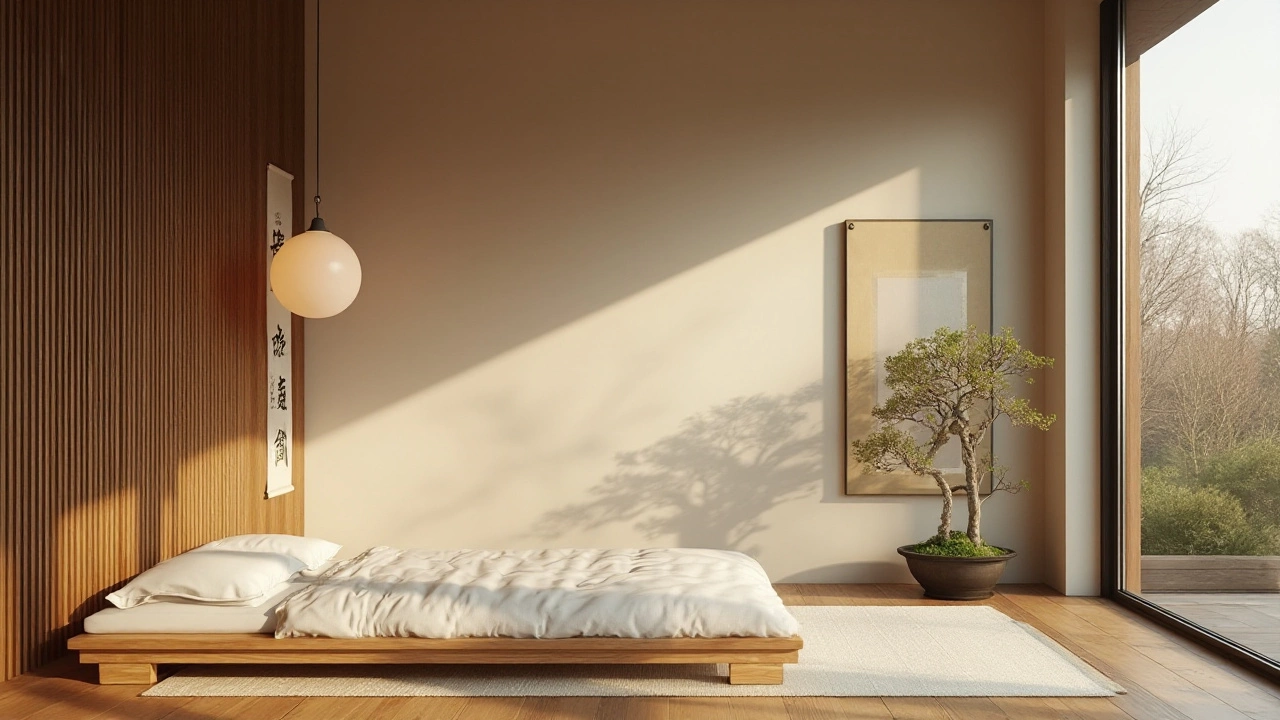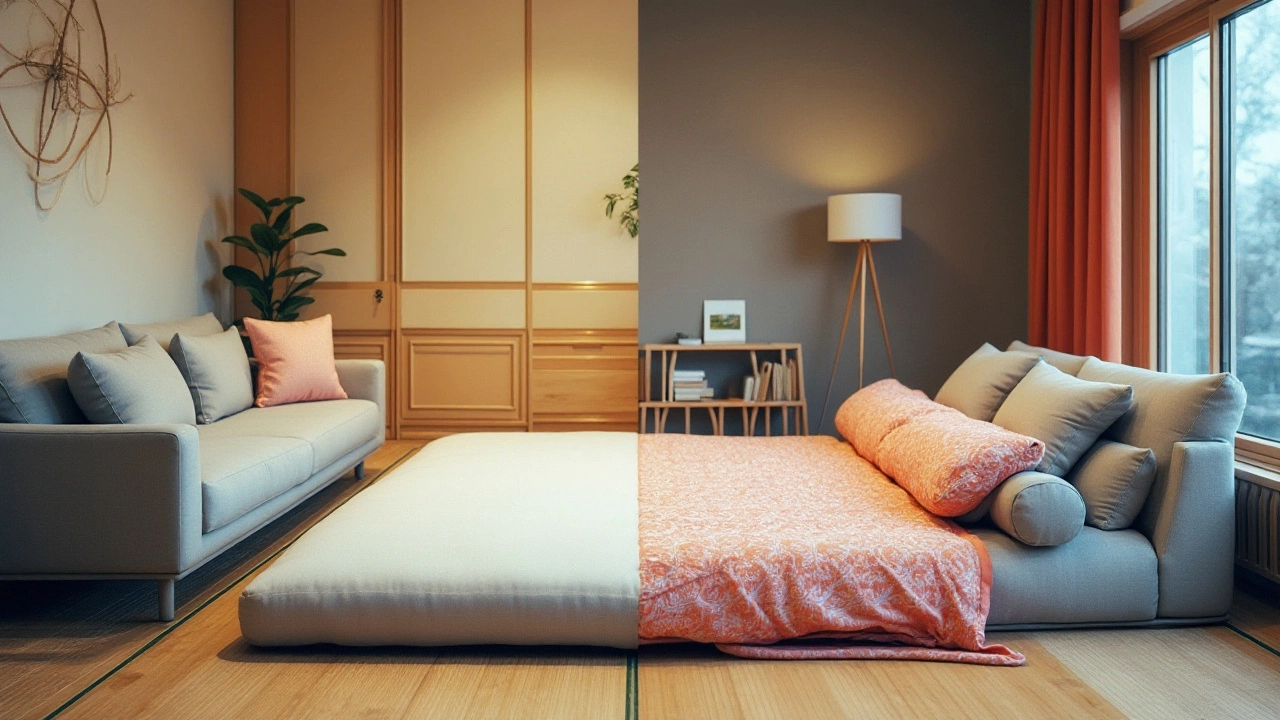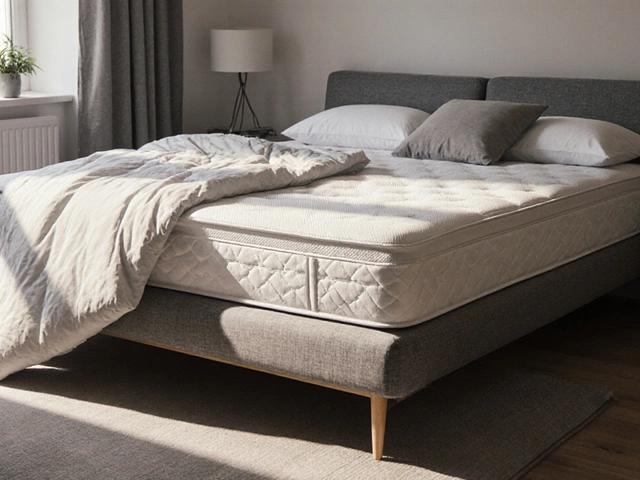 31
Jan,2025
31
Jan,2025
Japanese bedding offers a unique appeal, melding simplicity with functionality, and has captured the interest of many households globally. The use of traditional futons, laid upon tatami mats, epitomizes the minimalist aesthetic that is both efficient and stylish. With advancements in home design, many have started blending these traditional components with modern conveniences like sofa beds, resulting in a comfortable hybrid tailored for contemporary living.
To truly appreciate Japanese bedding, one must first understand the intricate balance it maintains between space-saving solutions and effective support for restful sleep. This guide will take you through the subtleties of Japanese culture as reflected in their sleeping arrangements, while also providing practical tips for integrating this timeless option into your own home.
- Introduction to Japanese Bedding
- What is a Futon?
- Understanding Tatami Mats
- Futons vs. Sofa Beds
- Care and Maintenance of Japanese Bedding
- Creating a Japanese-Inspired Bedroom
Introduction to Japanese Bedding
Japanese bedding, with its rich history and cultural significance, offers more than just a place to rest your head at night. It embodies a philosophy of living that is deeply tied to simplicity and efficiency. The quintessential components like the futon and tatami mats have evolved over centuries to provide not just comfort but also a harmonious setting that resonates with balance and tranquility. The practice of laying out a **futon** directly on the floor, traditionally on **tatami mats**, is rooted in the Japanese cultural emphasis on minimalism. This approach is more than just a space-saving hack; it’s a lifestyle that prioritizes connectedness with space and surroundings.
In Japan, the art of bedding is a nightly ritual. Traditionally, futons are not left out during the day; they are stored away to allow the room to serve multiple functions. This ritualistic approach underscores a versatile use of space and promotes a serene living environment. The futon itself is designed to be thin yet firm, offering support that professionals argue aligns with healthier sleep practices. Dr. Yoshihiko Takubo once mentioned that 'the absence of a thick mattress encourages better alignment of the spine.' This quote emphasizes the practical benefits of Japanese bedding, blending modern ergonomics with age-old wisdom.
The unique nature of Japanese bedding extends beyond its physical form. It influences how space is perceived and used, transforming the home environment. With styles dating back to pre-modern Japan, the transition from wooden beds to floor-based bedding was driven by a desire to increase room functionality and promote cleanliness, as
What is a Futon?
The Japanese bedding tradition of futons is steeped in centuries of history, reflecting a lifestyle that emphasizes simplicity and space-efficiency. A futon is typically composed of three main components: the mattress, the duvet or cover, and the pillow. Uniquely designed to be kept on tatami mats—woven straw pads that create a firm underlay—the futon's adaptability in small spaces is arguably its most treasured feature. Unlike the western-style beds that often eat up considerable floor space, futons can easily be folded and stored away during the daytime, offering the flexibility to use the room for various purposes beyond sleeping. Many Japanese households value this capability, particularly where living space is at a premium, showcasing how cultural practices align with a resourceful mindset in home management.
The construction of a futon mattress is an art in itself. Traditionally, futon mattresses are filled with cotton or synthetic fibers, designed to offer a supportive yet cushiony feel that promotes spinal alignment. This material allows the mattress to conform to the body, providing better weight distribution which contributes to a restful night's sleep. As modern design intersects with traditional practices, contemporary futons may sometimes incorporate latex or foam layers to enhance comfort. The dimensions of futons are generally thin compared to typical western mattresses, rendering it easier to manage while still upholding a high degree of comfort and utility.
Cultural and Practical Benefits
Futons are not just about sleep; they are integral to a cultural ethos that respects balance and mindfulness. The morning ritual of folding the futon and allowing it to air has practical benefits too. Exposure to sunlight and air helps to stave off moisture and keep the mattress fresh—a crucial step in a country with humid climates. Historically, the Japanese have always been keen on maintaining a clean sleeping environment, recognizing the health advantages, which is why aired bedding practices remain a staple to this day. According to a survey by the Japan Lifestyle Research Institute, about 60% of urban homes continue to use futons, favoring the versatility they bring compared to fixed bedroom formats.
Modern Adaptations
In recent years, the blend of traditional futons with contemporary furniture trends has given rise to attractive hybrids like the futon sofa bed. With cities growing denser and apartment spaces shrinking, modern adaptations of futons prove to be a practical solution. These sofa beds carry forward the ethos of multifunctionality intrinsic to futons, embracing a dual role as comfortable seating during the day that easily transforms into a sleeping surface when night falls. This evolution speaks to the enduring legacy and appeal of futons in a world that continually adapts to changing living dynamics. An increasing number of manufacturers now create these pieces with global tastes in mind, ensuring that the charm of Japanese bedding finds a place in homes all across the world.
Understanding Tatami Mats
Tatami mats, a hallmark of Japanese interior design, have been gracing homes for centuries with their unique combination of functionality and aesthetic appeal. Traditionally crafted from rice straw and woven with rush grass, these mats have provided a versatile and durable flooring solution in Japanese households, enhancing the warmth and ambiance of living spaces. The standard size of a tatami mat is approximately 90 cm by 180 cm, but they can vary slightly depending on regional preferences. Beyond their physical attributes, tatami mats are deeply culturally significant, embodying simplicity, respect for nature, and a keen attention to detail.
The versatility of tatami mats extends beyond their function as flooring. They offer a soft yet firm surface that is ideal for the placement of Japanese bedding, providing both support and insulation. Mats are carefully arranged to fit rooms precisely, often influencing the room's size designation—many traditional Japanese rooms are still measured by the number of tatami mats that fit within them. The natural materials used in their construction allow tatami to regulate humidity, absorbing moisture in the air during wet seasons and releasing it during dry periods, thus assisting in maintaining a balanced indoor climate. This quality not only aids comfort but also preserves the life of the interior furnishings.
The Cultural Essence
Delving deeper into the cultural significance, tatami mats hold symbolic meanings and traditional etiquettes. For example, historical customs dictated that tatami mats were reserved for the homes of nobility or for special occasions such as tea ceremonies and spiritual gatherings. The way a tatami is laid is also loaded with rules; for instance, their edges should not align when placed in a room, a custom believed to ward off bad luck. Even in modern housing design, the aesthetics and practical benefits of tatami are cherished, appreciated by those who seek a connection with the past while embracing contemporary living. According to the Japan Times, "Tatami adds an element of comfort and tradition that isn't easily replicated by other materials."
Additional allure lies in their natural fragrance, often described as having a soothing, earthy smell, reminiscent of freshly mown grass. This fragrance is said to invoke a sense of tranquility and can enhance the calming ambiance of a home. Appreciated by architects for their flexibility, tatami can adapt to different design aesthetics, from rustic to modern minimalist, and their function as a harmonizing element in interior design is undeniable. The Japanese appreciation for balance and symmetry is reflected in how tatami bring an organic softness that complements wooden elements, low furniture, and dim lighting, embodying a serene and grounded space that enhances relaxation and contemplation.
Installation of tatami mats requires a level of craftsmanship that respects both tradition and precision. Skilled artisans, sometimes referred to as 'tatami masters,' are sought after for their acute attention to detail. These craftsmen ensure each mat fits perfectly, is evenly stitched, and occasionally personalized with decorative borders, adding an artistic touch to their utility. As people around the world gain access to varied cultural practices, incorporating elements like tatami mats into household design offers a chance to adopt a piece of Japanese tradition, cementing a legacy of refined simplicity and function through cultural exchange.

Futons vs. Sofa Beds
When it comes to Japanese bedding, a fascinating comparison arises between traditional futons and modern sofa beds. Understanding these differences not only sheds light on different cultural perspectives but also helps in choosing the right option for your home. At first glance, futons might seem like simple mattresses, yet they are intricately designed to provide a firm and comfortable sleeping surface. Typically, a futon comprises three layers: an outer cover, the cotton or synthetic padding, and the inner core, which could be made of foam or additional layers of cotton. The beauty of a futon lies in its versatility. Unrolled by night, it turns into a cozy bed; rolled and stowed by day, it creates space and freedom, aligning with minimalist principles.
Sofa beds, on the other hand, reflect more of a Westernized approach to multi-use furniture. These ingenious pieces transform from seating to sleeping areas with a few adjustments. Unlike futons, which require a clear space on the floor, sofa beds already integrate into the existing room setup. They offer ease of use, particularly in smaller apartments and urban living arrangements where space is at a premium. The integration of mattresses in sofa beds has improved leaps and bounds over the years, providing genuine comfort with the added flair of traditional upholstery materials.
From a practical standpoint, the choice between futons and sofa beds often depends on lifestyle and living arrangements. Futons traditionally rest on tatami mats, enhancing their ergonomic benefits and providing natural insulation. This setup not only contributes to posture correction but also has a thermal regulation quality due to the natural properties of tatami. Conversely, sofa beds better serve those leaning towards a no-fuss, convenient lifestyle where cleaning and bed-making are concerned. It’s interesting to note that a study published in 'Home and Design' highlighted that futons are often associated with healthier sleep by promoting natural body alignment.
"Embracing the futon is more than a furnishing choice; it is an invitation to experience simplicity and transform your relationship with space." - Home and Design Magazine
Another point of divergence is the level of maintenance each requires. Futons need regular airing and fluffing to ensure they remain fresh and maintain their supportive qualities. Turning them over and occasionally washing the cover can significantly increase their longevity. Sofa beds, however, largely rely on the cleanliness of fabric covers and the condition of the inner mattress, which may require professional cleaning. Both options can boast sustainability, yet futons often have an edge due to their simple construction and use of natural materials.
When considering statistics, a survey by the International Sleep Products Association notes that 43% of those using futons report improved sleep environment satisfaction over their previous setups. This could possibly be attributed to the adjustment of sleeping height, the flexibility in using the room for other purposes, and a reduction in allergens due to easier cleaning routines. Whether you're drawn to the minimalist charm of a futon or favor the convenience and modernity of a sofa bed, the choice will invariably rely on personal preference, aesthetic inclination, and practical living conditions. Mixing both or opting for one over the other can redefine the way comfort and purpose blend harmoniously in your home.
Care and Maintenance of Japanese Bedding
Proper care and maintenance of Japanese bedding are essential to preserve its longevity and ensure a restful sleep experience. Starting with futons, which are often crafted from natural materials like cotton or wool, it is crucial to air them out regularly. This tradition of airing out futons not only helps to keep them fluffy and comfortable but also prevents moisture build-up that can lead to mold or mildew. On sunny days, take advantage of the natural UV light, which acts as a natural disinfectant, by hanging the futon outside. Weight is a consideration, so you'll want to make sure you have a secure place to hang these large items.
Regular cleaning is another aspect of maintaining your Japanese bedding. While many futons are designed to be spot cleaned, it is also recommended to use a vacuum cleaner specifically designed for beds to remove dust mites and allergens. Monthly, give your futon a gentle thrashing using a specialized futon beater, a tool that assists in bringing the material back to its original loftiness. Covering the futon with a washable cover is also a good practice; it offers an extra layer of protection and simplifies the cleaning process.
Caring for tatami mats, which form the foundation of traditional sleeping setups, also requires specific attention. Tatami mats are traditionally made from rice straw, with a top layer of woven soft rush straw, and need to be kept dry to prevent damage. Regular vacuuming with a brush attachment will help keep the surface clean and free of debris. If a spill occurs, immediate drying is needed, using a dry towel to absorb moisture. Periodically, shift the mats around to even out wear and exposure to sunlight, which can cause one side to fade more than the other.
Engaging with each piece of Japanese bedding is not merely a chore but aligns with the idea of minimalist living—where mindfulness and taking care of one's possessions feature prominently. By following these key practices, such as regular cleaning and thoughtful placement, your futon and tatami can last for years while maintaining their comfort and aesthetic value. This delicate handling echoes the Japanese philosophy of monozukuri, or craftsmanship, where every detail matters, reflecting a deep respect for the functionality and spirit of the materials.
"The essence of Japanese interior design lies in its subtlety and the ability to find beauty in simplicity," says architect Tadao Ando, who emphasizes the harmonious relationship between humans and their environments.
Mindful maintenance habits can transform the way you interact with your space. Consider adding a natural essential oil spray to mist the area just above your futon, introducing a calming scent to improve sleep quality. Also, be attentive during season changes, a time when adjusting how you care for your Japanese bedding can effectively respond to shifts in humidity and temperature, potentially extending their lifespan further. Embrace these timeless traditions, and your Japanese-inspired bedroom space will become an oasis of comfort and wellness.
Creating a Japanese-Inspired Bedroom
Creating a Japanese-inspired bedroom requires an understanding of the delicate balance between simplicity and functionality that forms the core of Japanese design philosophy. By embracing the minimalist approach, one can transform a cluttered space into a serene retreat. Begin by selecting a traditional Japanese bedding setup, like a futon paired with a tatami mat. The futon's portability offers flexibility, allowing you to roll it up during the day, maximizing your living space. Consider materials such as cotton or wool for the futon, which offer breathability and a soft touch. A tatami mat, usually composed of rice straw and rush grass, not only enhances the aesthetic with its natural texture but also anchors the futon aesthetically and provides insulation.
Incorporate natural elements wherever possible. Use shoji screens to partition spaces subtly while allowing light to permeate, creating an open essence even within a compact room. Floor-to-ceiling windows can enhance this by inviting more natural light and framing views of the outdoors, akin to a living painting. Opt for muted colors like soft whites, beiges, and grays to facilitate a calming ambiance, reflecting traditional Japanese themes. The introduction of indoor plants like bonsai or bamboo can add an organic feel, introducing a sense of tranquility and life.
Focus on sleek and functional furniture designed to avoid unnecessary clutter. Low-profile storage solutions are ideal; think built-in drawers or shelves that blend seamlessly with walls to maintain the room's flow. An efficient layout, with only essential pieces, enhances accessibility and highlights the open space. When it comes to decor, less is more. Select artwork that speaks to Japanese culture—perhaps a simple calligraphy piece or a framed origami—while maintaining an understated presence. It’s about quality, not quantity.
Pay attention to the room's acoustics as well. Natural fibers like those in tatami mats help absorb sound, reducing echoes and creating a hushed environment. You may want to introduce elements like a small indoor water feature. The gentle murmur of water provides a calming background, enhancing meditative aspects of the room. Traditional Japanese music or ambient nature tracks can also augment the space’s peacefulness.
"Simplicity is the ultimate sophistication." — Leonardo da Vinci. While not Japanese himself, da Vinci’s ethos captures the essence of Japanese design: elegant simplicity that emanates sophistication.
Lighting plays a crucial role in setting the vibe. Choose lanterns or light fixtures with wooden or paper elements matching the Japanese bedding theme. These offer a warm, soft glow reminiscent of sunrise, reinforcing a soothing bedroom atmosphere. Layer different light sources to position shadows harmonically, creating depth and highlighting key features. When seeking balance between traditional and modern facets, thoughtfully integrating tech with respect to the cultural aesthetic can elevate your experience; consider utilizing smart blinds or LED controllers discreetly used.




